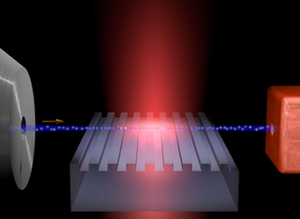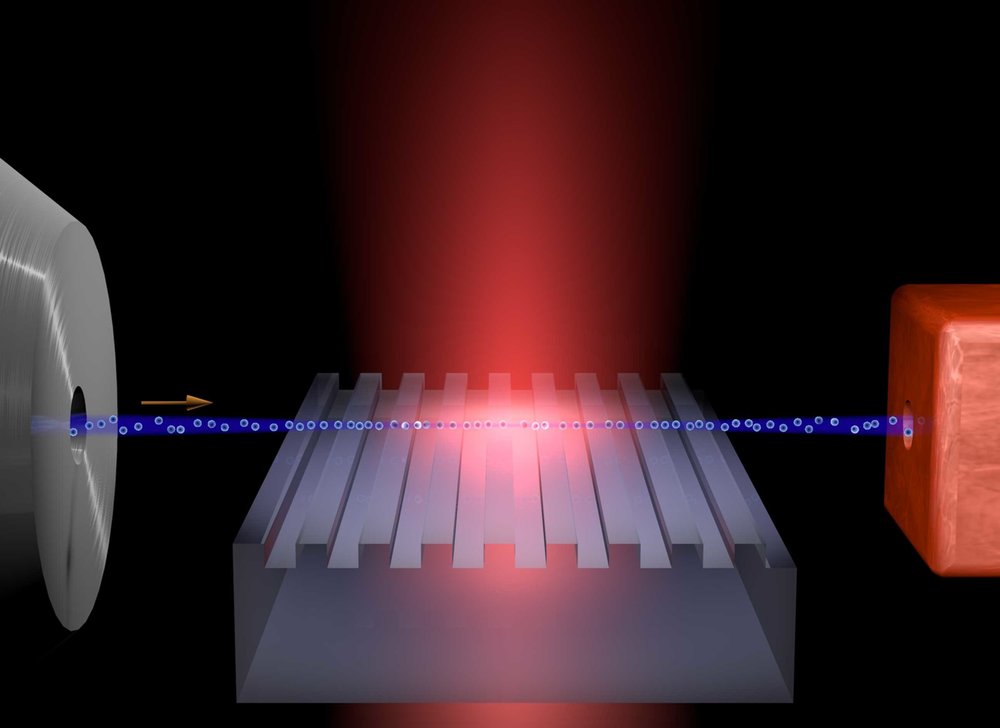Accelerating Electrons with Light
Particles in today’s accelerators are driven by radiofrequency waves, but using visible light should in principle allow for much smaller machines. In Physical Review Letters and Nature [1], two teams report the first experimental demonstrations of the direct use of visible light fields to accelerate electrons more rapidly than in conventional accelerators. The teams used tiny structures to generate electric field patterns that could accelerate the particles. Combining these structures and other components could one day lead to compact, laboratory-sized accelerators to drive versatile x-ray sources, perform particle experiments, or provide medical treatments.
In a linear accelerator, electrons run through a succession of metal tubes (electrodes) that have alternating positive and negative voltages. An electron is repelled by the negative voltage of a tube it’s passing through and attracted to the positive voltage of the next one, but by the time it reaches the positive tube, the voltages switch sign, pushing it farther forward. The voltages change sign at a radio frequency, and after many stages, the electrons build up enough energy to be used in collision experiments. They can also generate intense x rays for scattering or other experiments.
The strength of electric fields in accelerators is limited by the need to avoid damage to the metallic electrodes, so producing large particle energies requires many stages and thus huge facilities. Researchers have long known that using nonconducting materials at the higher frequencies of visible light could lead to smaller accelerators because the fields could be times higher without damage. But until now no one has built the tiny structures and assembled the apparatus needed to demonstrate acceleration using these high frequencies.
Two teams now report rapid acceleration of electrons using small silica structures to shape light fields into patterns similar to those in a linear accelerator. In both of the experiments, the researchers sent electrons skating just over a silica surface that contained narrow grooves in the direction perpendicular to the electron beam. They then shined ultrashort laser pulses directly onto the surface (called a grating), which generated a pattern where the electric field was alternately enhanced and diminished in neighboring “zones” just above the surface. This pattern of fields reversed direction twice during every oscillation cycle of the laser light and could accelerate electrons (see YouTube video).
John Breuer and Peter Hommelhoff of the Max Planck Institute of Quantum Optics in Garching and Friedrich Alexander University Erlangen-Nuremberg, both in Germany, worked with electrons moving at only about one-third of the speed of light, so they traveled only about nanometers during one light oscillation cycle. To generate the field zones with this separation, the grooves would also need a -nanometer spacing, but such a fine grating wasn’t available. So the team compromised with a -nanometer spacing, which gave electrons with the right speed a net “kick” every three cycles. However, the kicks weren’t as strong as the force of the peak electric field. For this reason and others, the efficiency to accelerate these slower electrons was lower than for electrons close to the speed of light, says Breuer.
But the researchers still measured an average field as high as megavolts per meter, which is comparable to that of conventional accelerators. To get the full benefit of this high accelerating field, Breuer says, the researchers will need to use a grating whose spacing gets continuously larger as an electron moves across, to match its increasing speed.
For this initial demonstration, the electron source was a modified electron microscope with a continuous beam, which allowed fine control of the beam position but did not allow the team to create pulses that could be synchronized with the laser pulses. In the future, Breuer says, a source allowing synchronized pulses will increase the number of electrons accelerated.
The second team, publishing in Nature and led by Robert Byer of Stanford University in Palo Alto, California, used a structure that comprises two face-to-face gratings separated by a precisely controlled gap of or nanometers [1]. In addition to having a more uniform field, calculations showed that this two-sided arrangement was necessary for acceleration of electrons traveling at essentially the speed of light. For the demonstration, the electrons came from the Next Linear Collider Test Accelerator at nearby SLAC National Accelerator Laboratory. The beam was much larger than the gap, so only about one electron in fifty entered the gap. But the team inferred that some of these electrons experienced an acceleration field of megavolts per meter, more than ten times higher than that in current accelerators.
“We’re pretty thrilled with this first result,” says Byer, but he acknowledges that they are at the beginning of a long process to develop the many elements of a working accelerator. The two teams are currently exploring ways to combine their devices to provide acceleration of low-energy electrons all the way up to near light speed.
“It’s a big leap forward,” says James Rosenzweig of the University of California, Los Angeles, since the two teams are not simply theorizing but performing detailed experiments. He says it’s still too early to know how this approach will compare with other proposals for compact accelerators, such as those that use a laser-generated plasma to push the electrons.
Correction (30 Sept. 2013): The description of the electric field pattern in the new accelerators is now more accurate. Unlike a linear accelerator, the field at every location points in the same direction, even though that direction oscillates in time (see video from SLAC).
–Don Monroe
Don Monroe is a freelance science writer in Murray Hill, New Jersey.
References
- E. A. Peralta et al., “Demonstration of Electron Acceleration in a Laser-Driven Dielectric Microstructure,” Nature (London) (2013)





